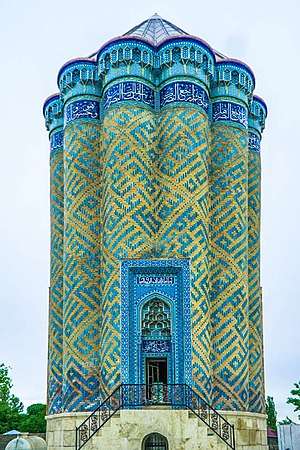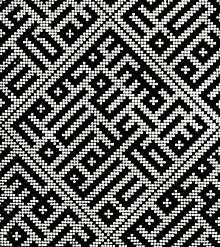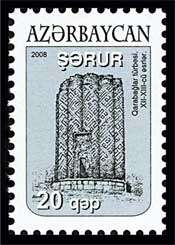Garabaghlar Mausoleum
Mausoleum in Garabaghlar village (Azerbaijani: Qarabağlar türbəsi) – is a mausoleum located in Garabaghlar village of Kangarli Rayon of Azerbaijan, about 30 kilometers far from the north-western part of Nakhchivan. The mausoleum, built in the first half of the 14th century is partially demolished and has a cylindrical form with twelve semicircular facets. The mausoleum, which has a circular form in the inner part, is 30 meters high. Two minarets having quadrangular foundation in the lower part are located about 30 meters far from the mausoleum. The minarets of the ensemble belong to the 12th century.[1][2]
| Qarabağlar türbəsi | |
 | |
| Location | Nakhchivan, Azerbaijan |
|---|---|
| Type | Mausoleum |
| Beginning date | 12th–14th centuries |
Garabaghlar Mausoleum is a complex including a tomb, two minarets and ruins of this monument locating between them. History of the minarets is dated back approximately to the late XII and early 13th centuries. Structure of a portal connecting two minarets of the mausoleum is the structure of the 14th century. There is a name of Goday khatun on this little portal. It is considered that this Goday khatun was Abaqa Khan’s (1265-1282) wife. It can make a conclusion that an architect, who set before himself a goal of building in honor of Gaday khatun within the new complexes built in the 12th–13th centuries, built this monument then. If it's true then it's possible that this building was built in honor of Goday khatun.
The history of the monument and its minarets can be also dated back to the 12th century – during the reign of Abu Said Bahadur khan (1319-1335) for its style and construction methods.
Architectural characteristics
The main characteristics of tower-shaped tombs can be seen in Garabaghlar mausoleum. The mausoleum is divided into two parts – a burial vault in lower part and upper overground part. The burial vault's plan is similar to Barda mausoleum. The overground part of Garabaghlar mausoleum is very interesting for its architectural structure. A trunk of the mausoleum standing on a stone pedestal is originated from connection of 12 semicylinders. The mausoleum is distinguished from other mausoleums located in Azerbaijan for architectural structure of its trunk. There is a boom with calligraphically written inscription on the top of the trunk as in Barda mausoleum. This inscription on Garabaghlar mausoleum was written with letters of white color and its background was made of blue frieze.
Four portals of the upper chamber are effectively allotted. Lancet arches with stalactitical infillings are centers of the southern, western and eastern portals. Slats with inscriptions written in neskh and stylized kufi are included into composition of portals. Stylized ornaments of plants dominate in the southern and western parts, but ornaments of the eastern part are geometric. Trunks of columns and their cubic capitals are also covered with composite mosaic.
A complicated system of stalactites underline a line of archivolt, infilling the space of an arched niche. Golden glaze is sparingly interspersed with ornamental patterns of the portal, which is not met in the area of the mausoleum anymore. Thanks to the deep niches in sides of a central square, the burial vault of the mausoleum has taken the form of an equal-ended cross. It was covered with mirrored groin vault. Walls are encased with two rows of thoroughly drafted stone plates over which oversails brick placement of cushions. The upper chamber is a straight 12 edged dimension of oversailed proportions. Rectangular niches on the walls are framed by more narrow equilateral niches. Top of the 12 edged trunk is surrounded by two-layered stalactite corbel, used as a crossover to the inner cupola, which is folded by stone blocks.[3]
Foundations of two minarets attached to portal are prolonged rectangular prisms. Facades of the foundations are treated with patterned placing framed with trilobite equilateral arch. Not tall, octahedral bulk is used as a pedestrian to cylindrical trunks of the minarets built of circle brick. Narrow bricks with turquoise glaze were put to vertical junctures of placing. Image of the placing gets across an Arabic ligature, beginning in the trunk of one of the minarets and finishing in the other. The inscription is written in accurate kufi script, which is similar to inscription on Momine Khatun Mousileum's frame board. Terra-cotta colored letters were placed against a turquoise background – this method is relatively rare in architecture found in Azerbaijan dating to the Middle Ages.

Top of the minarets are heavily demolished. Narrow spiral stairs built of simple tablet bricks (20x20x5) wave within the minarets. There are saved remains of imposts of arches and found out multiple remains of walls in different levels of masonries of the mausoleum's minarets. There was a significantly bigger portal in the place of existing one, about which evidence fragments of masonry, which oversails the bay between minarets. Glaze with mosaic patterns yields to glaze of the minarets and mausoleum in quality and its background is black. Glaze is covered with grid of capillary cracks and weakly connected to a crock. Motifs of ornaments of the mausoleum's decoration aren’t met in decors of the minarets’ portal. Remains of an inscription written in neskh indicates about an order of construction of the mausoleum and name “…Jehan Gudi-khatun”. Perhaps, there is mentioned Kufi-khatun, one of the wives of Hulaku khan, mother of Tekuder – Sultan Ahmad.
Excavations of 1940, found out walls of a building a band of which's placing is dated back to the same time with the placing of the minarets. Configuration of a plan and dimensions of premises reminds of khanega. Walls of the building are detached far from the mausoleum.

Peculiarities of architectural structure of the mausoleum indicate that masters of various architectural professions were involved in its construction. Despite a generality of the composition and architectural appearance of the portals, detailed representation of the arches’ archivolts is also original. There are patterns which aren’t met in other portals. Ligatures common for style are differently interpreted and placed on planes; decorations included in images of the ligatures are diverse; butts of the ornament's band are authorized differently, which are common for some portals for their images. Characterizing architecture of the mausoleum, its corrugated surface, determining architectural expressiveness of its appearance in a significant level should be especially mentioned. This method acquired extremely wide propagation both timely and territorially. This method was initially met and widely used mainly in pre-feudal defense constructions of Trans-Caspian. Distribution of this method to memorial (Mausoleums of Garabaghlar, Radkan and Kishmar) and cultic (Jar-Kurgan) constructions dates back to the earlier time. Barda mausoleum is the most similar to Garabaghlar mausoleum by analogy.[4]
References
- "Azərbaycan Respublikası Xarici İşlər nazirliyinin Naxçıvan Muxtar Respublikasındakı idarəsi". Archived from the original on 2012-01-05.
- Л. С. Бретаницкий, Б. В. Веймарн. Очерки истории и теории изобразительных искусств.Искусство Азербайджана. p. 136.
- "Нахчивань".
- "Нахчыван. Мавзолей Карабаглар. XII - XIII в.в."